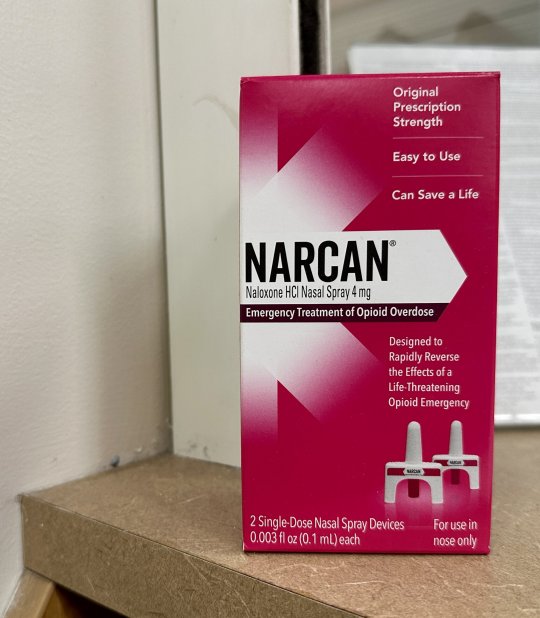 A box of Narcan nasal spray, the opioid-reversing medication that has been approved for over-the-counter use, sits on a pharmacy counter on Feb. 22, 2024. (Photo: Sapna Bansil)
A box of Narcan nasal spray, the opioid-reversing medication that has been approved for over-the-counter use, sits on a pharmacy counter on Feb. 22, 2024. (Photo: Sapna Bansil)ANNAPOLIS (March 7, 2024)—Jackson Taylor remembers when a peer passed out from an overdose across from his high school. He knows friends who have struggled with addiction. One has been in and out of rehab.
Those experiences help explain why the Rockville High School senior now trains his peers on how to administer naloxone, a lifesaving medication that reverses opioid overdoses. They're why he carries naloxone at school and why he wants all districts to let their students do the same.
"It's just like a student having a heart attack," said Taylor, who runs a student task force on drug and opioid issues in Montgomery County. "It might be rare, but on the off chance it happens, you want to be able to save them and help them."
Currently, a disparate and ambiguous set of district-level policies has created confusion on the role students may play in preventing opioid deaths among their peers. But a bill before the Maryland General Assembly aims to provide a clear and uniform set of standards. The measure, HB 1268, would explicitly authorize students across the state to possess and administer naloxone—also known by its brand name, Narcan—as adolescent opioid deaths surge and teens lobby for urgent solutions.
While the practice is already permitted for students in Montgomery County, others have gotten punished for carrying naloxone in school, according to the bill's sponsor, Del. Joe Vogel, D-Montgomery.
"We know that our student populations are uniquely vulnerable when it comes to [the opioid] issue," Vogel said. "And this [bill] is, to me, a common-sense step to say, 'Hey, you should not be punished for carrying naloxone with you in a school hallway, and you should not be punished for saving a classmate's life if they're overdosing.'"
At a hearing before the House Ways and Means Committee on Wednesday, Taylor, 18, was among those who testified in support of the measure. So, too, did Maryland's Special Secretary of Opioid Response, Emily Keller, an indication that the bill has the backing of Gov. Wes Moore's administration.
"Empowering people and giving them the tools necessary to help is a vital strategy, especially with young people," Keller said in her testimony. "Making naloxone accessible with every Marylander is one of our priorities because we know it's the number one life-saving tool."
The bill responds to an alarming national trend: Between 2018 and 2022, adolescent deaths from opioids quadrupled, according to an analysis by KFF.
The rise in overdoses has coincided with two factors, said Patricia Kapunan, the medical director for Montgomery County Public Schools. One is the use of social media to market pills without a prescription. The other is the rise of fentanyl, a potent synthetic opioid that is being mixed with illegal drugs, often unbeknownst to the user and with deadly effects.
In 2021, fentanyl was involved in nearly four times as many fatal overdoses among young people in Maryland as the next deadliest drug, cocaine, according to the state's Vital Statistics Administration.
"Suddenly, [fentanyl] is showing up everywhere, and suddenly one pill can kill," Kapunan said.
Implementation questions
In response to the opioid crisis, lawmakers have mandated that school districts take preventive actions. The Start Talking Maryland Act of 2017 required public schools to teach kids about the dangers of opioids and have naloxone available on campuses. It also authorized nurses and other health and school personnel to administer the medication in overdose emergencies.
Most districts have not extended the same permission to students. In Cecil County, students are not necessarily punished for possessing naloxone, according to director of student and school safety John Roush. But "they would be talked to by their school administration about it and informed that we don't have a policy for [them] to carry that in schools," he said.
Roush thinks the bill is a good idea and may help save lives, though he anticipates challenges with implementation and logistics.
"We have over 15,000 kids in our system here," he said. "How do you get Narcan out? How do you get information out? How do you make them educated on the use? How do you make them aware? It seems like there would be a lot of time and details to be worked out in that regard."
While the bill requires schools to educate students about the benefits of naloxone, it does not specifically address one major logistical consideration: training kids on how to dispense the medication.
Available over the counter as a nasal spray, Narcan must be administered by tilting the person's head back and firmly pressing the plunger. Because the medication's effects are temporary and overdose symptoms may return, it is critical that the individual providing Narcan also call 911 and seek medical aid.
To the American Medical Association, the benefits of expanding naloxone access in schools still outweigh the risks. Following a debate on the issue, the group approved a resolution last year encouraging "states, communities and educational settings to remove barriers to students carrying safe and effective overdose reversal medications."
"Narcan saves people quickly, and lack of Narcan kills people quickly," said Kenneth Certa, an AMA delegate from the American Psychiatric Association, which co-sponsored the policy. "When somebody is turning blue and cold, you don't have much time. And to wait until a dose gets from another part of the building can be too late."
'Hugely empowering'
In Montgomery County, which saw a 78% spike in youth overdoses from 2021 to 2022, a policy permitting students to carry naloxone took effect on May 1, 2023.
Kapunan, who crafted the measure, said students were never punished for possessing overdose-reversing medications and were already protected under good samaritan laws if they acted in an emergency. But teen advocates nonetheless pressed for a policy change that eliminated ambiguity and codified their right to intervene.
"Those levels of permission were really important to students," Kapunan said. "For me, it was a very small part of the regulation. For them, it was hugely empowering."
Kapunan says the policy does not mean schools are depending on kids to save lives. During the 2022-23 school year, naloxone was dispensed on school grounds in Montgomery County 18 times, almost always by nurses. Since the policy change, there have been no known instances of a student administering naloxone to a peer at school.
But to supporters, the measure remains an important preventive step, permitting those in closest proximity to an overdose to act without fear of repercussion.
"Students know before the teachers do, is the truth," Taylor said. "I'm a lot more likely to know, 'Hey, my friend has a pill in his bag that he's thinking about taking, and it could have a repercussion' than a teacher would know."
Vogel, who is running for the open U.S. congressional seat in Maryland's 6th District, said expanding policies like the one in Montgomery County has become a necessity. Six months ago, he met with student leaders who spoke to the urgency of the opioid crisis and their desire to help address it.
"A lot of them have taken matters into their own hands," Vogel said. "A number of them have stepped up and said, 'We want to get trained on how to administer naloxone, and we want to be able to carry naloxone.' … That's what this bill is in response to."


